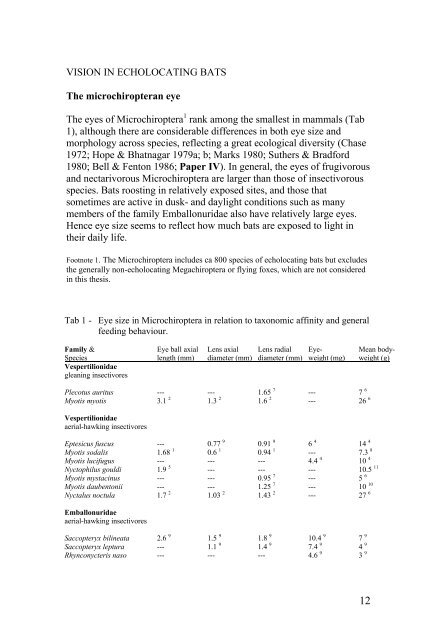Vision in echolocating bats - Fladdermus.net
Vision in echolocating bats - Fladdermus.net
Vision in echolocating bats - Fladdermus.net
You also want an ePaper? Increase the reach of your titles
YUMPU automatically turns print PDFs into web optimized ePapers that Google loves.
VISION IN ECHOLOCATING BATS<br />
The microchiropteran eye<br />
The eyes of Microchiroptera 1 rank among the smallest <strong>in</strong> mammals (Tab<br />
1), although there are considerable differences <strong>in</strong> both eye size and<br />
morphology across species, reflect<strong>in</strong>g a great ecological diversity (Chase<br />
1972; Hope & Bhatnagar 1979a; b; Marks 1980; Suthers & Bradford<br />
1980; Bell & Fenton 1986; Paper IV). In general, the eyes of frugivorous<br />
and nectarivorous Microchiroptera are larger than those of <strong>in</strong>sectivorous<br />
species. Bats roost<strong>in</strong>g <strong>in</strong> relatively exposed sites, and those that<br />
sometimes are active <strong>in</strong> dusk- and daylight conditions such as many<br />
members of the family Emballonuridae also have relatively large eyes.<br />
Hence eye size seems to reflect how much <strong>bats</strong> are exposed to light <strong>in</strong><br />
their daily life.<br />
Footnote 1. The Microchiroptera <strong>in</strong>cludes ca 800 species of echolocat<strong>in</strong>g <strong>bats</strong> but excludes<br />
the generally non-echolocat<strong>in</strong>g Megachiroptera or fly<strong>in</strong>g foxes, which are not considered<br />
<strong>in</strong> this thesis.<br />
Tab 1 - Eye size <strong>in</strong> Microchiroptera <strong>in</strong> relation to taxonomic aff<strong>in</strong>ity and general<br />
feed<strong>in</strong>g behaviour.<br />
Family & Eye ball axial Lens axial Lens radial Eye- Mean body-<br />
Species length (mm) diameter (mm) diameter (mm) weight (mg) weight (g)<br />
Vespertilionidae<br />
glean<strong>in</strong>g <strong>in</strong>sectivores<br />
Plecotus auritus --- --- 1.65 7 --- 7 6<br />
Myotis myotis 3.1 2 1.3 2 1.6 2 --- 26 6<br />
Vespertilionidae<br />
aerial-hawk<strong>in</strong>g <strong>in</strong>sectivores<br />
Eptesicus fuscus --- 0.77 9 0.91 9 6 4 14 4<br />
Myotis sodalis 1.68 1 0.6 1 0.94 1 --- 7.3 8<br />
Myotis lucifugus --- --- --- 4.4 4 10 4<br />
Nyctophilus gouldi 1.9 5 --- --- --- 10.5 11<br />
Myotis mystac<strong>in</strong>us --- --- 0.95 7 --- 5 6<br />
Myotis daubentonii --- --- 1.25 7 --- 10 10<br />
Nyctalus noctula 1.7 2 1.03 2 1.43 2 --- 27 6<br />
Emballonuridae<br />
aerial-hawk<strong>in</strong>g <strong>in</strong>sectivores<br />
Saccopteryx bil<strong>in</strong>eata 2.6 9 1.5 9 1.8 9 10.4 9 7 9<br />
Saccopteryx leptura --- 1.1 9 1.4 9 7.4 9 4 9<br />
Rhynconycteris naso --- --- --- 4.6 9 3 9<br />
12


